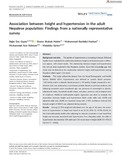Association between height and hypertension in the adult Nepalese population: Findings from a nationally representative survey
Date
2019-11-07Publisher
WileyAuthor
Gupta, Rajat DasHaider, Shams Shabab
Hashan, Mohammad Rashidul
Rahman, Muhammad Aziz
Sarker, Malabika
Metadata
Show full item recordCitation
Das Gupta, R., Haider, S. S., Hashan, M. R., Rahman, M. A., & Sarker, M. (2019). Association between height and hypertension in the adult Nepalese population: Findings from a nationally representative survey. Health Science Reports, 2(12) doi:10.1002/hsr2.141Abstract
Background and aims
The burden of hypertension is increasing in Nepal. Different studies have evaluated the relationship between height and blood pressure in different regions, with mixed results. The relationship between height and hypertension has not yet been explored in the Nepalese context. Given this knowledge gap, this study aims to determine the relationship between height and hypertension among Nepalese adults (aged ≥18 years).
Methods
This study utilized the dataset from the Nepal Demographic and Health Survey (NDHS) 2016. Hypertension was defined as systolic blood pressure ≥ 140 mmHg and/or a diastolic blood pressure ≥ 90 mmHg. Height, measured in centimeters (cm), was analyzed as a continuous variable. Based on previous evidence, the following covariates were considered: age, sex, presence of overweight or obesity, educational status, household wealth status, and place, province, and ecological zone of residence. Multilevel multivariable logistic regression was done to evaluate the association between height and hypertension. Both crude odds ratio (COR) and adjusted odds ratio (AOR) are reported, along with a 95% confidence interval (CI). Sample weight of NDHS was adjusted during analysis.
Results
Among 13 393 weighted individuals over the age of 18 years, the prevalence of hypertension in Nepal was found to be 21.1% (95% CI, 19.9%‐22.4%). In the final multivariable model, after adjusting for relevant covariates, it was found that height was inversely associated with hypertension. For a Nepalese adult, the odds of hypertension decreased by 10% with each 10‐cm increase in height (AOR 0.9; 95% CI 0.8‐0.9; P = 0.003).
Conclusion
Awareness should be raised among people with low stature for prevention of hypertension. Longitudinal studies are recommended to include genetic and social/environmental determinants of stature in the analyses.

